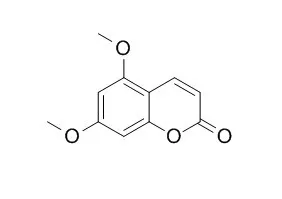| Cell Research: |
| Acta Pol Pharm. 2014 Nov-Dec;71(6):1066-72. | | EPR studies of free radicals in A-2058 human melanoma cells treated by valproic acid and 5,7-dimethoxycoumarin.[Pubmed: 25745781] | Free radicals in A-2058 human melanoma cells were studied by the use of electron paramagnetic resonance (EPR) spectroscopy. The aim of this work was to determine the changes in relative free radical concentrations in tumor A-2058 cells after treatment by valproic acid (VPA) and 5,7-dimethoxycoumarin ((Citropten, DMC).
METHODS AND RESULTS:
The influences of VPA and DMC on free radicals in A-2058 cells were compared with those for human melanoma malignum A-375 and G-361 cells, which were tested by us earlier. Human malignant melanoma A-2058 cells were exposed to interactions with VPA, DMC, and both VPA and DMC. The tumor cells A-2058 were purchased from LGC Standards (Lomianki, Poland), and they were grown in the standard conditions: at 37°C and in an atmosphere containing 95% air and 5% CO2, in the Minimum Essential Medium Eagle (MEM, Sigma-Aldrich). The A-2058 cells were incubated with VPA (1 mM) and DMC (10 μM) for 4 days. The first-derivative EPR spectra of the control A-2058 cells, and the cells treated with VPA, DMC, and both VPA and DMC, were measured by the electron paramagnetic resonance spectrometer of Radiopan (Poznań, Poland) with microwaves from an X-band (9.3 GHz). The parameters of the EPR lines: amplitudes (A), integral intensities (I), line widths (ΔBpp), and g-factors, were analyzed. The changes of amplitudes and line widths with microwave power increasing from 2.2 to 70 mW were drawn evaluated, o-Semiquinone free radicals of melanin biopolymer are mainly responsible for the EPR lines of A-2058 melanoma malignum cells. The amounts of free radicals in A-2058 cells treated with VPA, and both VPA and DMC, were lower than in the untreated control cells. Application of the tested substances (VPA, and both VPA and DMC) as the antitumor compounds was discussed. DMC without VPA did not decrease free radicals concentration in A-2058 cells.
CONCLUSIONS:
The studies con-firmed that EPR spectroscopy may be used to examine interactions of free radicals with antitumor compounds. |
|






 Cell. 2018 Jan 11;172(1-2):249-261.e12. doi: 10.1016/j.cell.2017.12.019.IF=36.216(2019)
Cell. 2018 Jan 11;172(1-2):249-261.e12. doi: 10.1016/j.cell.2017.12.019.IF=36.216(2019) Cell Metab. 2020 Mar 3;31(3):534-548.e5. doi: 10.1016/j.cmet.2020.01.002.IF=22.415(2019)
Cell Metab. 2020 Mar 3;31(3):534-548.e5. doi: 10.1016/j.cmet.2020.01.002.IF=22.415(2019) Mol Cell. 2017 Nov 16;68(4):673-685.e6. doi: 10.1016/j.molcel.2017.10.022.IF=14.548(2019)
Mol Cell. 2017 Nov 16;68(4):673-685.e6. doi: 10.1016/j.molcel.2017.10.022.IF=14.548(2019)